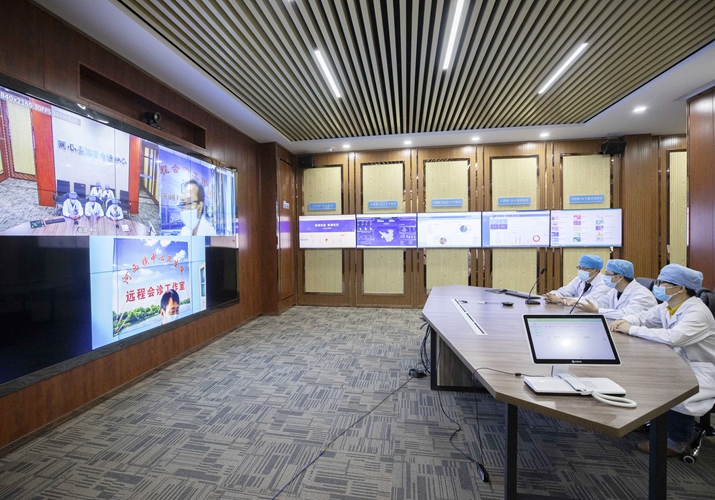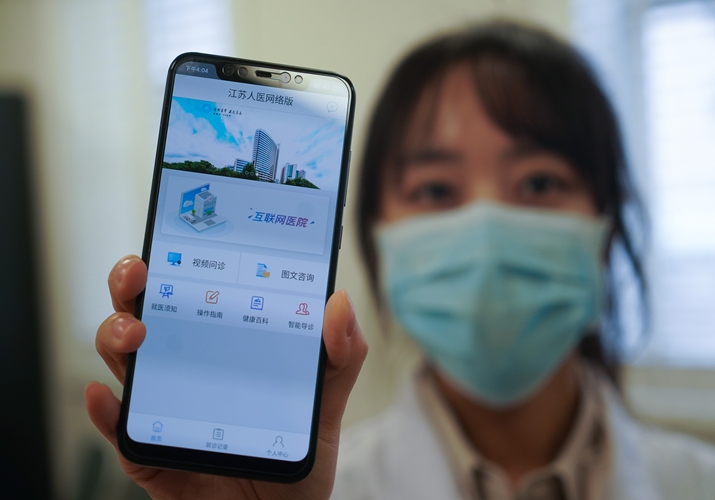| Business |
| China's Internet-based healthcare platforms gain further growth | |
|
|
 Medical experts from Fujian Province, southeast China, provide guidance online for doctors in a hospital in Tongxin County, Ningxia Hui Autonomous Region in northwest China, on September 20(XINHUA)
JD Health, the online healthcare platform of China's e-commerce giant JD.com, released the prospectus for an initial public offering (IPO) on the Hong Kong Stock Exchange on November 26, aiming to sell 381.9 million shares through the IPO to raise up to $3.4 billion. Operating as a subsidiary since 2019, it has become the third online healthcare platform going public in China, following Ali Health of e-commerce giant Alibaba and the platform Ping An Good Doctor under the financial firm Ping An Insurance Group.
Online healthcare services mainly include telemedicine and online sales of drugs, which can enhance the efficiency of medical services, bring convenience to users and drive the progress of medical and information technologies, Lu Qingjun, Director of the National Telemedicine and Connected Health Center, told Beijing Review. In recent years, China has seen a boom in the sector with more players entering the field and further government support. Besides JD.com and Alibaba, tech companies including Tencent and Baidu have also developed smart healthcare businesses.
Internet hospitals developed by enterprises and physical hospitals have seen further growth. China's first Internet hospital WeDoctor was set up in Wuzhen, Zhejiang Province in east China, in December 2015. According to Mao Qun'an, an official with the National Health Commission, at a forum held in Beijing at the end of this October, the number of Internet hospitals operating in China had already reached 900 by the time.
As people were encouraged to avoid visiting public places when the novel coronavirus disease (COVID-19) hit many regions in China earlier this year, the demand for remote diagnosis and treatment grew exponentially. To meet the surging demand, the government released a new guideline at the end of February to include Internet-based medical services and subsequent treatments under the medical insurance coverage. The government has also stressed the need to improve online payment services for telemedicine and expand channels for medicine purchase. Since 2015, over 100 policies and rules on online healthcare have been released.
The scale of China's online healthcare market will reach 200 billion yuan ($30.4 billion) this year due to the impact of the epidemic and favorable policies, according to the forum.
 A staff member of an Internet hospital in Jiangsu Province, east China, shows the app of the hospital on February 7(XINHUA)
Expanding market
Online healthcare platforms have seen improvements in their performance with the growth in demand for drugs and medical consultations. Many consumers turned to online pharmacies to purchase medical supplies including masks and surgical alcohol and made online appointment for nucleic acid tests in the previous months.
Data from Beijing-based consultancy Analysys Qianfan showed that daily active users for online medical consultation apps peaked at more than 6 million during the Spring Festival holidays from January 24 to February 2 this year when the epidemic was spreading domestically, increasing by 1.6 million, a year-on-year growth of 31.28 percent. As more people have developed the habit of using online platforms, China-based research firm AskCI Corp. projected the market scale of online medical consultancy to reach 22 billion yuan ($3.3 billion) this year and grow to 68 billion yuan ($10.3 billion) in 2022 in a report released in September.
Over the past months, online healthcare platforms backed by enterprises have been deeply involved in the anti-epidemic battle and registered remarkable revenue growth. Starting from April, Ali Health offered appointment services for nucleic acid tests in more than 30 domestic cities. JD Health and WeChat, Tencent's social media app, also provided the services in a dozen cities.
According to the prospectus of JD Health, its total revenue in the first three quarters of this year reached 13.2 billion yuan ($2 billion). In the first six months, its net profit totaled 371 million yuan ($56 million). Although Ali Health saw losses in 2019, it has turned the tide this year. A business report released by the company on November 25 showed that it has made profit for the first time since it was established in 2014. Its profit in the second and third quarter reached 279 million yuan ($42.4 million), up 286.4 percent year on year. During the period, the gross merchandise value of its pharmacy on Alibaba's online marketplace Tmall exceeded 55.4 billion yuan ($8.4 billion). As of the end of September, the number of its active users reached more than 250 million, the highest among China's online healthcare platforms.
In the first half of this year, the total revenue of Ping An Good Doctor came in at around 2.7 billion yuan ($411 million), up about 20 percent year on year. The average number of consultations on its app per day reached 831,000, with a year-on-year growth of 26.7 percent, a business report from the platform in August showed.
During the epidemic, Internet and physical hospitals have also been further integrated in many regions to meet the surging demand for diagnosis and treatment. According to the China Hospital Information Management Association under the Chinese Hospital Association, 42.37 percent of China's physical hospitals had provided Internet-based services by the end of 2019. "The figure has continued to rise this year. Before February, only six public hospitals in Beijing provided online medical services, while the epidemic pushed the number to 60, given the large demand," Lu said.
The growth of Internet hospitals has also greatly benefited patients in remote regions. People living in Tumxuk, Xinjiang Uygur Autonomous Region in northwest China, once had to travel a long distance to get to hospitals due to its vast size. In 2018, the first Internet hospital in the region started to operate in Tumxuk. A remote surgery in the hospital guided by experts in Guangdong Province, south China, helped save the life of a local farmer severely hurt by farm machinery in April.
According to the AskCI report, the application of 5G technologies this year will further help Internet hospitals improve their telemedicine services, which can reduce the gap between different regions in medical treatment, improve efficiency and help hospitals save costs.
Addressing problems
Although the epidemic has provided opportunities for online healthcare platforms to expand the user base, major challenges lie in achieving sustained growth with more people returning to physical hospitals with the easing of containment measures. The quality of drugs sold online has also triggered concerns. As Qin Mingwei, Director of the Telemedicine Center at Peking Union Medical College Hospital, told a conference on China's Internet hospitals held in late August, physical hospitals need to expand the coverage of online services and improve the quality of medical treatment instead of seeking expansion blindly.
"Departments need to develop unified standards to regulate Internet hospitals and online pharmacies, make medical insurance cover more diseases that can be treated in the hospitals and avoid malicious competition," Wen Jian, an expert with the Chinese Research Hospital Association, told the conference, stressing that Internet hospitals based in smaller cities and counties need to be boosted.
However, it will be a long road for small hospitals to develop Internet hospitals, because experienced medical staff and equipment are still mainly based at large hospitals. To enhance online healthcare in small cities and counties, Lu believes that large hospitals need to play a leading role in developing full-fledged telemedicine platforms which can be later expanded to lower-tier hospitals.
For more rapid development of Internet hospitals, more efforts are necessary. "Efforts are needed to improve smart healthcare technologies, better protect users' privacy through big data management and enhance online payment services for telemedicine," Lu said.
(Print Edition Title: Bridging the Distance)
Copyedited by Madhusudan Chaubey
Comments to lixiaoyang@bjreview.com
|
|
||||||||||||||||||||||||||||
|
